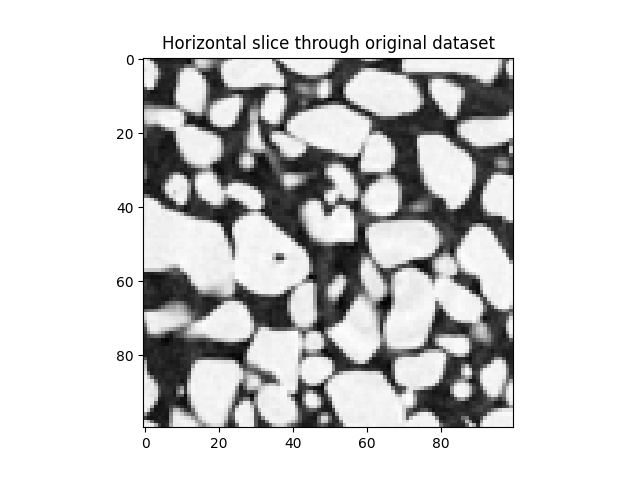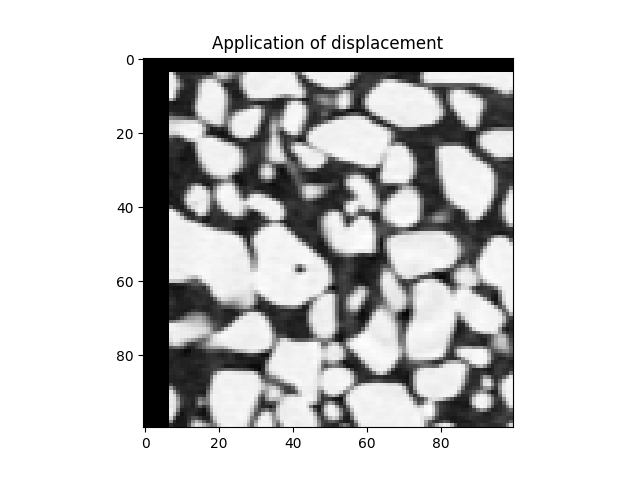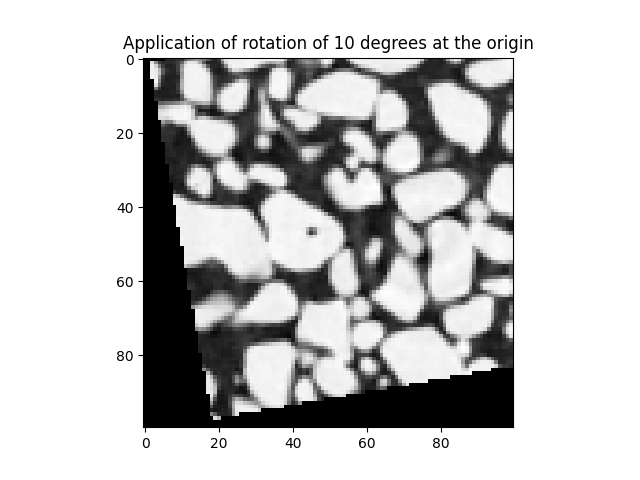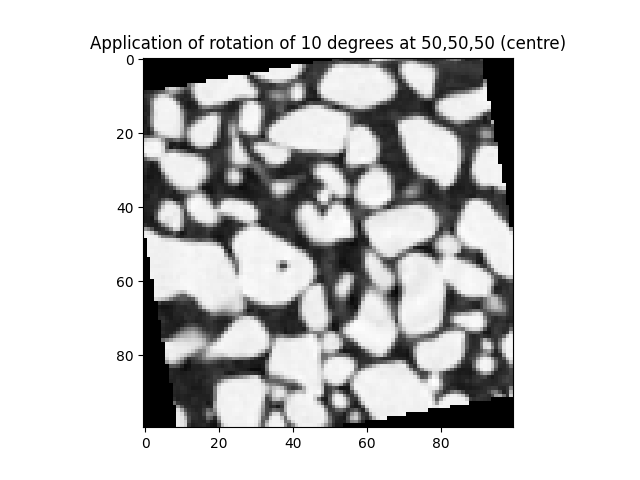Note
Go to the end to download the full example code.
Displace images with a linear and homogeneous deformation function#
In this example a linear homogeneous deformation function \(\Phi\) is firstly created and then is used to deform an image.
Import modules#
import matplotlib.pyplot as plt
import spam.deformation
import spam.DIC
import spam.datasets
Load and show data#
snow = spam.datasets.loadSnow()
print(snow.shape)
# Show the middle horizontal slice of the snow data set, visualised with ``matplotlib``
plt.figure()
plt.title("Horizontal slice through original dataset")
plt.imshow(snow[50], cmap='Greys_r', vmin=8000, vmax=36000)

(100, 100, 100)
<matplotlib.image.AxesImage object at 0x7f11a766da80>
Apply a displacement#
Let’s build a \(\Phi\) corresponding to an in-plane (i.e., X and Y) translation of 3 pixels in the Y direction and 5.5 pixels in the X direction (although given that it is a pure translation it would be pretty easy to manually write all the components of \(\Phi\) by hand).
Please note: Since trilinear image interpolation is enabled by default, applying a displacement of 5.5 in the X direction is indeed meaningful.
transformation = {'t': [0.0, 3.0, 5.5]}
Phi = spam.deformation.computePhi(transformation)
# Apply :math:`\Phi` to the snow volume
snowDeformed = spam.DIC.applyPhi(snow, Phi=Phi)
# The output will still be 100x100x100, meaning that some data's been lost.
print(snowDeformed.shape)
# output: (100, 100, 100)
# Show the middle horizontal slice of the deformed snow data set
plt.figure()
plt.title("Application of displacement")
plt.imshow(snowDeformed[50], cmap='Greys_r', vmin=8000, vmax=36000)

(100, 100, 100)
<matplotlib.image.AxesImage object at 0x7f11a76f56f0>
Apply a rotation#
Mathematically speaking, rotations are applied around the origin:
$$O = (0,0,0)$$
Which in this case is not the middle of the image, but the top-left-back of the image, which is a little unnatural for the application of rotations. Let’s apply a +10 degree rotation (i.e., anti-clockwise) and overwrite our translation and \(\Phi\) and check:
transformation = {'r': [10.0, 0.0, 0.0]}
Phi = spam.deformation.computePhi(transformation)
print(Phi)
[[ 1. 0. 0. 0. ]
[ 0. 0.985 -0.174 0. ]
[ 0. 0.174 0.985 0. ]
[ 0. 0. 0. 1. ]]
There are no translations (0,0,0,1 in the right-most column), so this is a pure rotation. Mathematically speaking, rotations are defined as positive-anticlockiwse around the origin at (0,0,0). Let’s apply it to the snow dataset in the same way as above :
snowDeformed = spam.DIC.applyPhi(snow, Phi=Phi, PhiCentre=[0.0, 0, 0.0])
# Show the middle horizontal slice of the deformed snow data set
plt.figure()
plt.title("Application of rotation of 10 degrees at the origin")
plt.imshow(snowDeformed[50], cmap='Greys_r', vmin=8000, vmax=36000)

<matplotlib.image.AxesImage object at 0x7f11a766e770>
It is usually more logical to apply \(\Phi\) (if it is anything other than a pure translation) to the middle of the image – this is the default behaviour (i.e., PhiPoint = (numpy.array(im.shape) - 1) / 2.0)):
snowDeformed = spam.DIC.applyPhi(snow, Phi=Phi)
# Show the middle horizontal slice of the deformed snow data set
plt.figure()
plt.title("Application of rotation of 10 degrees at 50,50,50 (centre)")
plt.imshow(snowDeformed[50], cmap='Greys_r', vmin=8000, vmax=36000)
plt.show()

You can see that the point of application of this linear transformation is important.
Total running time of the script: (0 minutes 0.324 seconds)
